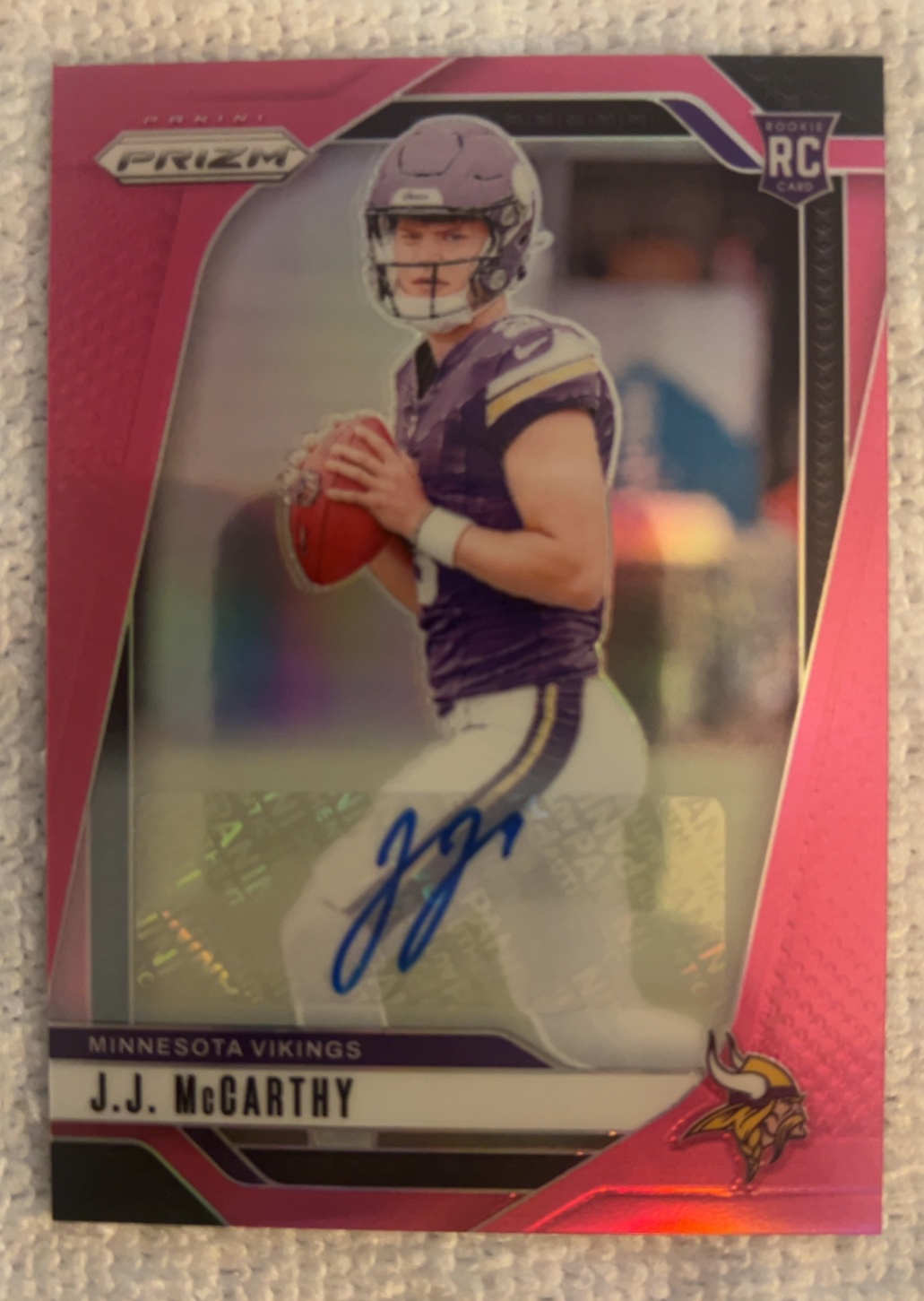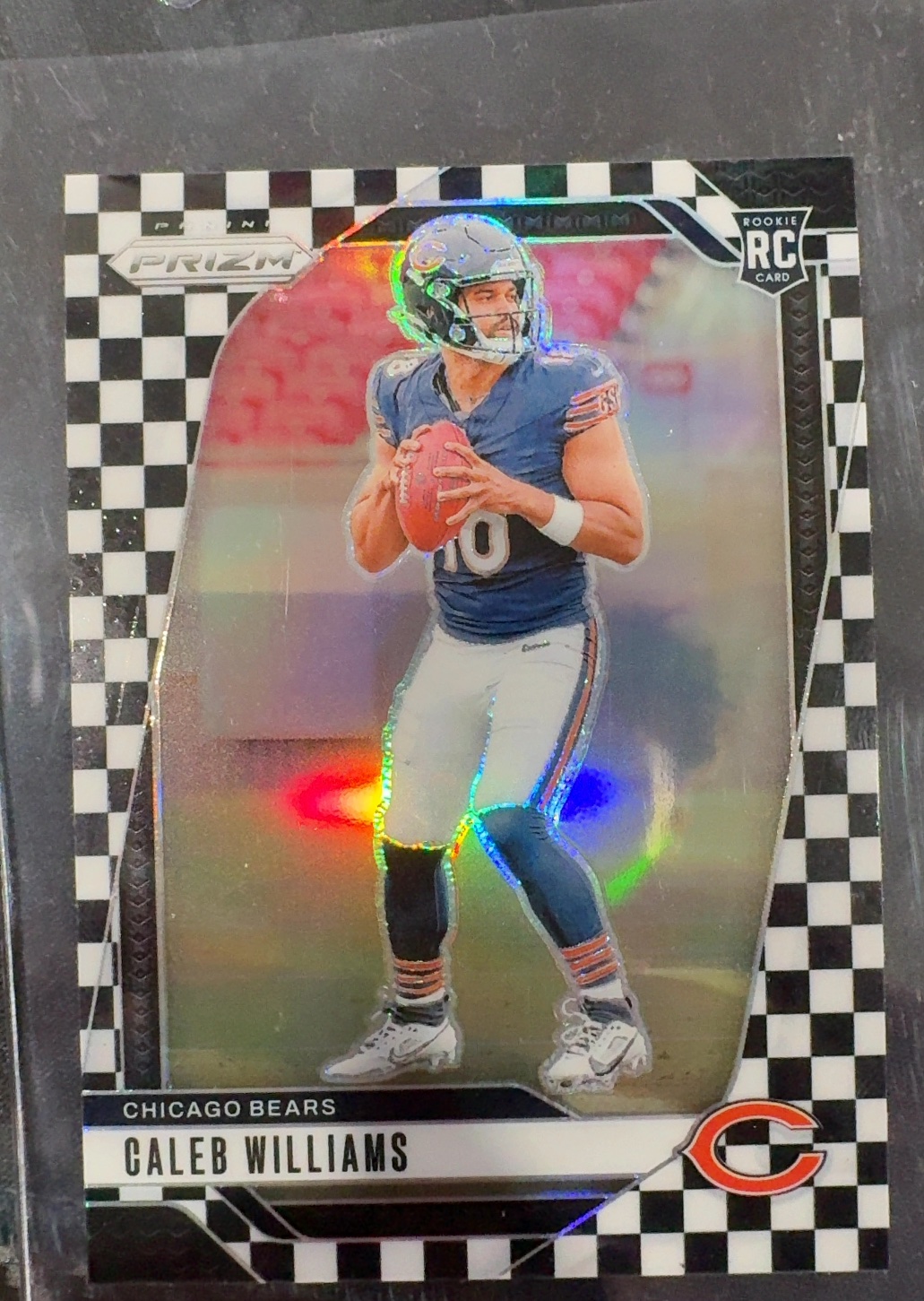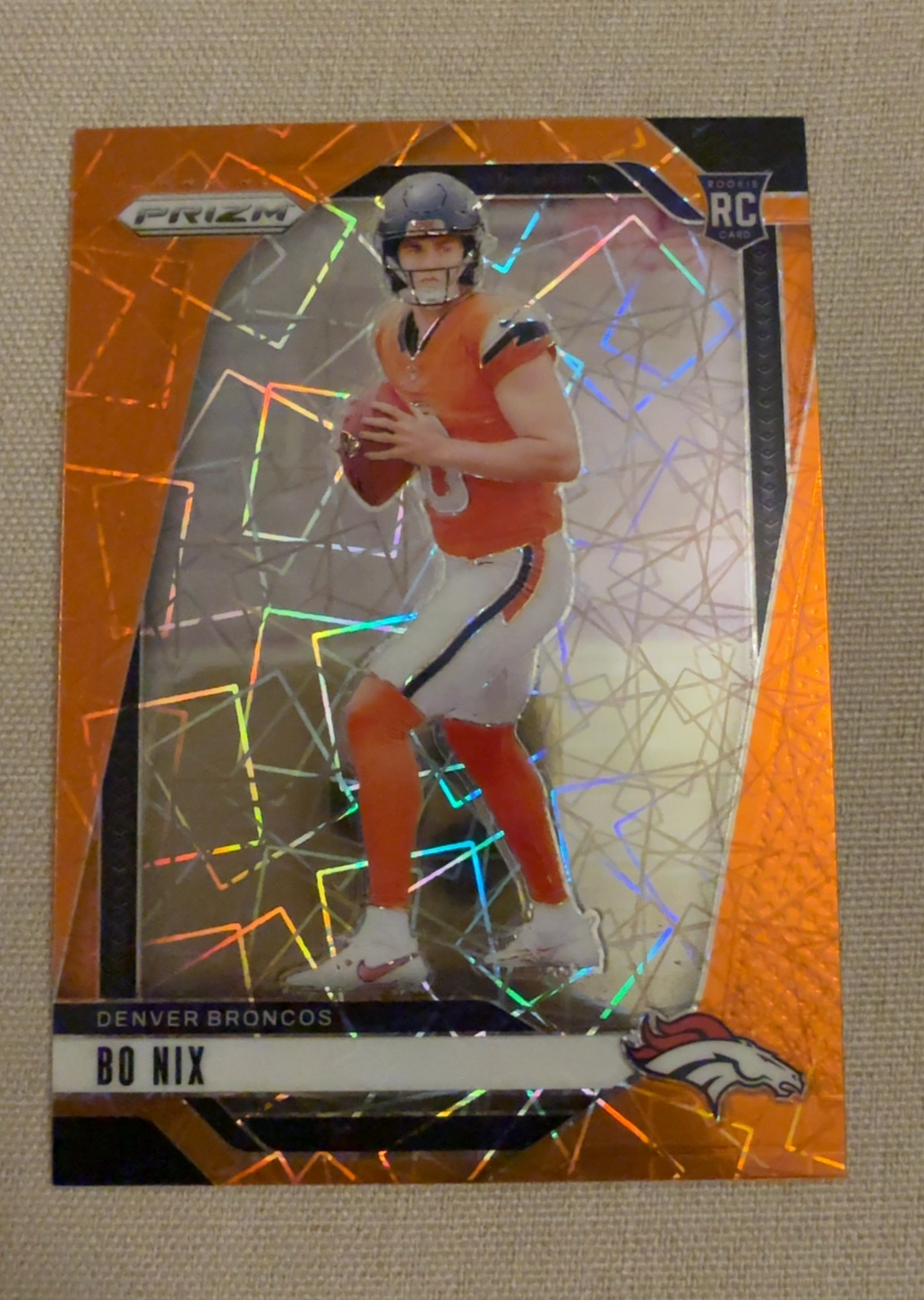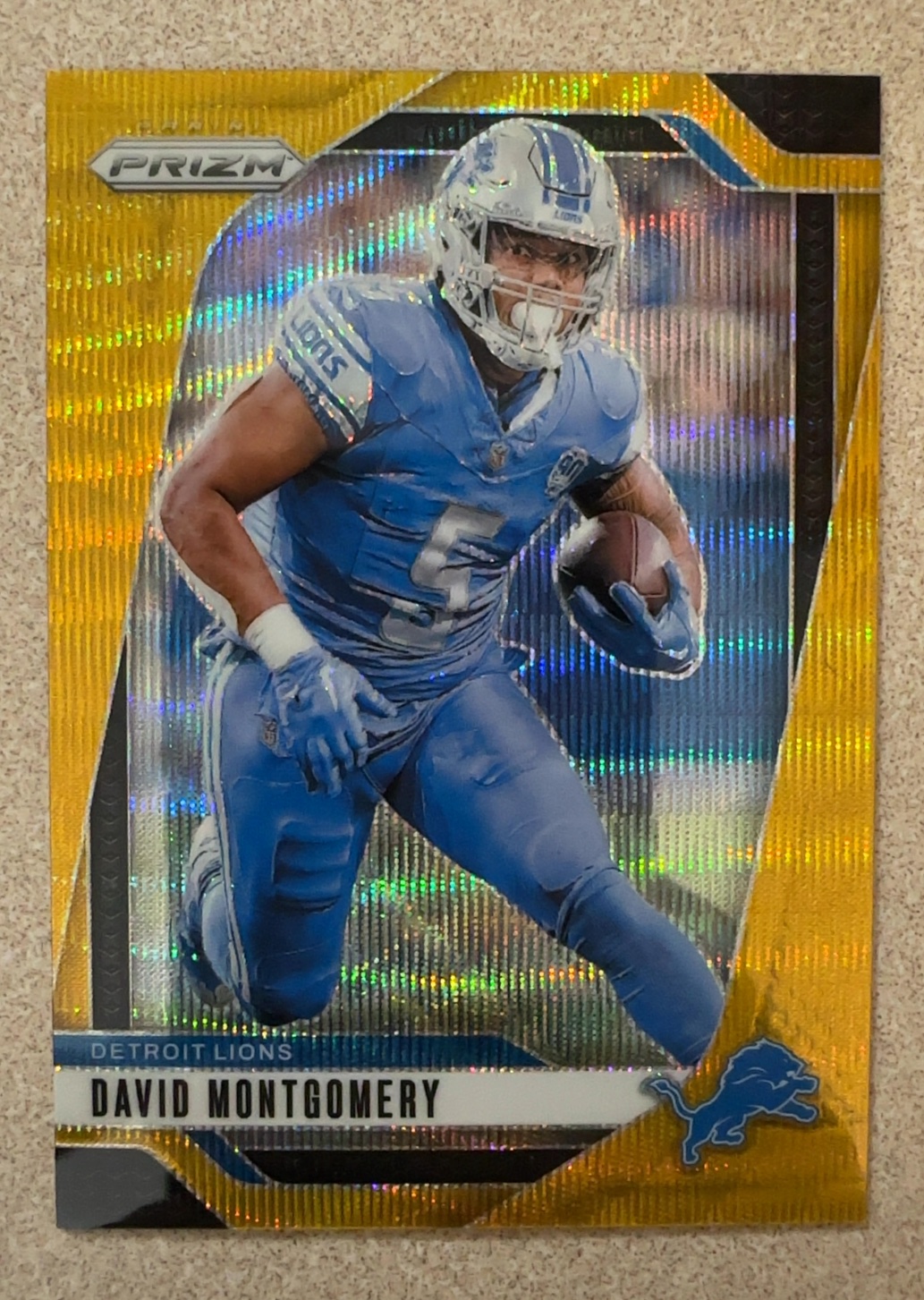Optic vs. Prizm 2024: Real Prizm Sales That Forecast Optic Rookie Card Values
Optic vs. Prizm 2024: What Prizm’s Market Is Signaling for Optic
Donruss Optic and Prizm are the two chromium flagships that define modern football singles. If you’re plotting your Optic chase list or deciding which Rated Rookies and parallels to grade, one of the best early tells is how analogous Prizm cards are actually selling right now. Below, we use real, recent eBay comps from four 2024 Prizm cards—J.J. McCarthy, Caleb Williams, Bo Nix, and David Montgomery—to map pricing tiers, grading upside, and parallel scarcity you can apply directly to Optic.
Rookie Autos: How Prizm McCarthy informs Optic Rated Rookie Autos
The 2024 QB class is driving both brand ecosystems. Prizm’s J.J. McCarthy Pink Prizm Auto is a clean comp for projecting Optic Rated Rookie Autos.
Our sample card, 2024 Prizm J.J. McCarthy Pink Auto, graded an AI-estimated 9.56 with near-perfect centering and a single moderate surface scratch noted. That surface note matters—true gem rates drive big premiums in both Prizm and Optic.

Filtering the data: We removed non-Prizm sales (e.g., a Donruss Optic Pink Prizm Auto /50), collegiate “Draft Picks”, and other Prizm autos like Choice/No Huddle/Blue Shimmer. After filtering for true 2024 Prizm Pink Prizm Auto #400, raw sales consistently cluster around $301–$405, with a midpoint near $335–$360. Graded Pink results reinforce the tiering: a PSA 9 Pink was around $380, while a PSA 10 Pink sold for about $1,026.
Optic read-through: Optic Rated Rookie Autos for top QBs typically shadow Prizm pricing by parallel rarity and condition. Expect Optic’s entry-level serials (e.g., /299, /199 tiers) and non-serial Holo autos to mirror this raw vs. PSA 10 spread—strong gem premiums with raw clustering in a tighter band. If your Optic pull has even a single surface scratch, consider selling raw or pre-grading via Fast Scan before you pay submission fees.
SSP Parallels: Checkerboard behavior (Caleb Williams)
Both Optic and Prizm use Checkerboard-style SSPs in retail. Prizm gives us a current market snapshot.
Our sample card, 2024 Prizm Caleb Williams Checkerboard, graded an AI-estimated 8.25 due to a small crease and light scratches—precisely the kind of condition dip that erodes SSP grading upside.

Filtering the data: We excluded Select checkerboards and color-numbered versions to isolate Prizm #301 Black & White Checkerboard SSP. After filtering, raw sales land around $167–$225 with an average near $200. A PSA 9 moved at about $225.63, while a PSA 8 hit roughly $200.
Optic read-through: Non-numbered SSPs in Optic (like Checkerboard) behave similarly unless there’s an added insert premium (e.g., Downtown). With an estimated 8–8.5, grading often won’t add enough value to beat fees. For clean Optic copies (no creases, minimal print), PSA 10 probability is the swing factor—use CardGrader.AI to pre-screen before submitting.
Color Tiers and “Color Match” Premiums: Bo Nix Orange as a pricing map
Orange parallels show how the market prices look-alike hues at different rarity levels—critical for Optic given its own rich parallel ladder.
Our sample card, 2024 Prizm Bo Nix Orange, is centered slightly off but otherwise clean (AI-estimated 9.16). The raw market splits by Orange type:

- Orange Lazer (Prizm): Filtered raw sales cluster ~$30–$35; PSA 9 ~$42–$54; PSA 10 ~$195–$215.
- Orange Disco (Prizm): Raw ~$49–$59; PSA 9 ~$50; PSA 10 around $165 (more data still emerging).
- Orange Ice (Prizm): Raw ~$140; PSA 10 ~$605–$615.
Filtering the data: We segmented by exact parallel language in titles (Lazer, Disco, Ice) and excluded Select /499 shocks and other brands. The result is a clear tiering that you can map to Optic’s hierarchy (e.g., Holo < Aqua/Scope/Velocity < Gold/Gold Vinyl). Expect Optic’s true color-match and lower serials (like Pink Velocity/Black Velocity) to command the “Orange Ice” style premium when they hit PSA 10s.
Veteran Gold Liquidity: Why subset matters
Gold /10 is king in both brands, but not all golds perform equally—especially for vets.
Our sample card, 2024 Prizm David Montgomery Gold #/10, graded an AI-estimated 9.65 with excellent edges and centering.

Filtering the data: We separated base #94 Gold /10 from insert-subset golds (e.g., “Deca #103”). After filtering, raw sales ranged widely from about $31–$150 depending on subset and serial (jersey-number matches got a bump). A PSA 10 base gold reached roughly $202.50. The average across mixed subsets landed around $65–$70, which aligns closely with the AI-estimated raw value.
Optic read-through: For non-rookie vets, Optic Gold (/10) still sells well, but subset desirability is crucial (base vs. insert, team color-match, photo). If you pull an Optic Gold of a non-QB vet, check comps by exact card ID and subset before grading; liquidity can vary more than you think.
Actionable Checklist for Optic 2024 Buyers
- Filter aggressively: On eBay, separate Optic from Prizm, and isolate exact parallels (Holo vs. Velocity vs. Scope). Tiny title differences can swing prices 2–5x.
- Grade only what can gem: Use CardGrader.AI’s upload to spot centering, scratches, and corner nicks before submitting. Gem premiums are where the money is.
- Respect the tiering: Non-serial Holos and retail-only patterns price like Prizm’s Lazer/Disco; serial Velocity and true color often mirror “Orange Ice” tiering in gem form.
- QB heat is real: McCarthy and Nix comps show raw clustering plus big PSA 10 multipliers. Expect similar behavior for Optic Rated Rookies.
Bottom line
Prizm’s live 2024 market is already revealing how Optic will likely price by player, parallel, and condition. Pink McCarthy autos show the raw-to-PSA 10 spread you can expect for Optic Rated Rookie autos; Caleb’s Checkerboard demonstrates how SSPs behave when they aren’t gem candidates; Bo Nix’s Orange family proves tiering matters more than color alone; and the Montgomery Gold /10 reminds us that subset and jersey-number trivia can move prices for non-rookie vets. Do your filtering, aim for gems, and let objective condition data guide your Optic buy/sell decisions.
Have Optic or Prizm you want to evaluate? Scan them now and make your next move with confidence.